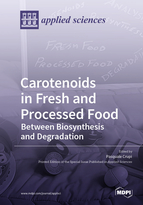Carotenoids in Fresh and Processed Food: Between Biosynthesis and Degradation
A special issue of Applied Sciences (ISSN 2076-3417). This special issue belongs to the section "Chemical and Molecular Sciences".
Deadline for manuscript submissions: closed (31 May 2021) | Viewed by 13051
Special Issue Editor
Interests: metabolomics analyses of food products; primary and secondary metabolites analyses; metabolic fingerprinting analyses; metabolite profiling analyses
Special Issues, Collections and Topics in MDPI journals
Special Issue Information
Dear Colleagues,
Currently, there is a general trend in food science to link food and health in line with consumers’ concern about what is in their food and how what they eat can promote well-being. Thus, food is considered today not only a source of energy but also an affordable way to prevent future diseases. In this context, studying carotenoids content in food is very relevant; indeed, epidemiological studies have demonstrated that the consumption of diets rich in carotenoids is associated with a lower incidence of cancer, cardiovascular diseases, and age-related macular degeneration, mainly due to their antioxidant and provitamin A activity. Although many works have been conducted about the presence and properties of carotenoids in food, some challenges must be still faced in this research field: The role of carotenoids as antioxidants and its mechanism of action are needed to be investigated further; detailed qualitative and quantitative composition of carotenoids in underutilized fruits and vegetables is required for contributing significant information to select nutrient rich plants for food formulation; how emerging packaging and processing techniques (i.e., high electric field pulse, high-pressure CO2, etc.) can preserve the content of carotenoids in processed food products; the complete understanding of carotenoid biosynthesis, regulation, and roles of various carotenoid derivatives for edible plants and animals is still not well established; and detailed studies for identifying the pre- and post-harvesting favorable factors (i.e. elicitors, cooking methods, etc.), which improve the bioavailability and bioaccessibility of carotenoids from different foods, are necessary.
The Special Issue of the journal Applied Sciences “Carotenoids in Fresh and Processed Food: Between Biosynthesis and Degradation” aims to group original research articles and review articles that can improve the knowledge in the aforementioned fields.
Dr. Pasquale CrupiGuest Editor
Manuscript Submission Information
Manuscripts should be submitted online at www.mdpi.com by registering and logging in to this website. Once you are registered, click here to go to the submission form. Manuscripts can be submitted until the deadline. All submissions that pass pre-check are peer-reviewed. Accepted papers will be published continuously in the journal (as soon as accepted) and will be listed together on the special issue website. Research articles, review articles as well as short communications are invited. For planned papers, a title and short abstract (about 100 words) can be sent to the Editorial Office for announcement on this website.
Submitted manuscripts should not have been published previously, nor be under consideration for publication elsewhere (except conference proceedings papers). All manuscripts are thoroughly refereed through a single-blind peer-review process. A guide for authors and other relevant information for submission of manuscripts is available on the Instructions for Authors page. Applied Sciences is an international peer-reviewed open access semimonthly journal published by MDPI.
Please visit the Instructions for Authors page before submitting a manuscript. The Article Processing Charge (APC) for publication in this open access journal is 2400 CHF (Swiss Francs). Submitted papers should be well formatted and use good English. Authors may use MDPI's English editing service prior to publication or during author revisions.
Keywords
- Carotenoids chemistry
- Apocarotenoids chemistry
- Fruits and vegetable
- Nonvegetable food
- Post-harvest physiology
- Biosynthesis
- Isomerization and degradation
- Bioavailability and bioaccesibility
- Methods of analysis






